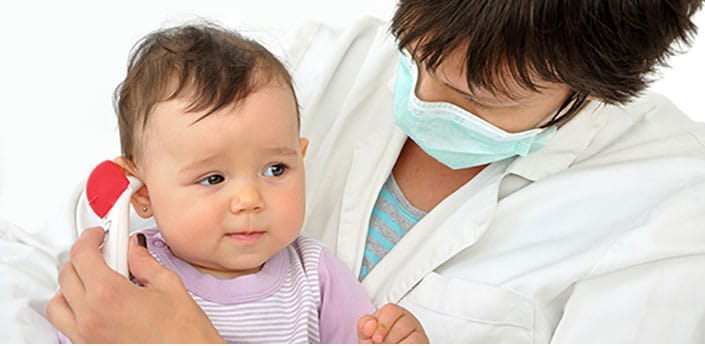What to know
- HPIVs commonly infect infants, young children, and people with weakened immune systems.
- People can get multiple HPIV infections in their lifetime.
- There is no specific antiviral treatment for HPIV illness. Most HPIV illnesses are mild and typically require only treatment of symptoms.

Overview
HPIVs belong to the Paramyxoviridae family. They are enveloped RNA viruses. There are four types (1 through 4) and two subtypes (4a and 4b) of HPIVs. The clinical and epidemiological features for each HPIV type can sometimes vary.
In the United States, infections associated with HPIV-1 usually peak every other year. Infections with HPIV-2 also peak every other year, during the years when HPIV-1 is low. HPIV-3 usually has peaks annually, particularly when HPIV-1 and HPIV-2 are low. Infections with HPIV-4 are less well-defined but appear to occur yearly.
HPIVs commonly infect infants, young children, and persons with weakened immune systems. However, anyone can get HPIV infection.
Symptoms and illnesses
The incubation period, the time from getting infected with HPIV to onset of symptoms, is generally 2 to 6 days.
- HPIV-1 and HPIV-2 are most often associated with croup, with HPIV-1 most often identified as the cause in children. Both can also cause upper and lower respiratory illness and cold-like symptoms.
- HPIV-3 is more often associated with bronchiolitis, bronchitis, and pneumonia.
- HPIV-4 is recognized less often but may cause mild to severe respiratory tract illnesses.
Upper respiratory illness from any HPIV is generally common cold symptoms. Signs and symptoms may include:
- fever
- runny nose
- cough
- sneezing
- sore throat
Other symptoms of HPIV illness may include:
- ear pain
- irritability
- decreased appetite
HPIVs can also cause more serious illness. Clinical syndromes in children include:
- croup (infection of the vocal cords [larynx], windpipe [trachea], and sometimes into the bronchial tubes [bronchi])
- bronchitis (infection of the main air passages that connect the windpipe to the lungs)
- bronchiolitis (infection in the smallest air passages in the lungs)
- pneumonia (an infection of the lungs)
Symptoms of more serious illness may include:
- barking cough
- hoarseness
- stridor (noisy or high-pitched sound with breathing)
- wheezing
In adults, upper respiratory infections and bronchitis are the most common illnesses caused by HPIVs; signs and symptoms may include fever, runny nose, cough, and sore throat. Pneumonia may occur, especially in older adults and people with weakened immune systems.
Reinfections
People can get multiple HPIV infections in their lifetime. These reinfections usually cause mild upper respiratory tract illness with cold-like symptoms. However, reinfections can cause serious lower respiratory tract illness, such as pneumonia, bronchitis, and bronchiolitis in some people. Older adults and people with weakened immune systems have a higher risk for severe infections.
Most children 5 years of age and older have antibodies against HPIV-3 and approximately 75% have antibodies against HPIV-1 and HPIV-2.
Transmission
HPIVs usually spread by direct contact with infectious droplets or by airborne spread when an infected person breathes, coughs, or sneezes.
HPIVs may remain infectious in airborne droplets for over an hour and on surfaces for a few hours depending on environmental conditions.
People are most contagious during the early stage of illness.
HPIV Seasons
There are four types of HPIVs and two subtypes that circulate at different times of the year.
- HPIV-1 infections often cause croup in children. There are usually more cases in the fall of every other year.
- HPIV-2 infections can also cause croup. HPIV-2 infections occur more commonly in the fall of every other year during the years when HPIV-1 is low. It is less frequently detected than HPIV-1 and HPIV-3.
- HPIV-3 infections usually occur in spring and early summer months each year. However, HPIV-3 infections can occur throughout the year, particularly when HPIV-1 and HPIV-2 are not in season.
- HPIV-4 (subtypes 4a and 4b) seasonal patterns are not as well characterized, but appear to occur in fall and winter each year.
Prevention and treatment
Currently, there is no vaccine to prevent HPIV infection. However, researchers are trying to develop vaccines. Also, there is no specific antiviral treatment for HPIV illness. Most HPIV illnesses are mild and typically require only treatment of symptoms.
In hospital settings, healthcare providers should follow contact precautions, such as handwashing and wearing protective gowns and gloves. For more information, see CDC's 2007 Guideline for Isolation Precautions: Preventing Transmission of Infectious Agents in Healthcare Settings.
Resources
Human Parainfluenza Surveillance, National Respiratory and Enteric Virus Surveillance System (NREVSS)
- American Academy of Pediatrics. Parainfluenza Viral Infections. In: Kimberlin DW, Banerjee R, Barnett ED, Lynfield R, Sawyer MH, eds. Red Book: 2024 Report of the Committee on Infectious Diseases. American Academy of Pediatrics; 2024: 630-632.
- DeGroote NP, Haynes AK, Taylor C, Killerby ME, Dahl RM, Mustaquim D, Gerber SI, Watson JT. Human parainfluenza virus circulation, United States, 2011-2019. J Clin Virol. 2020;124:104261.
- Abedi GR, Prill MM, Langley GE, Wikswo ME, Weinberg GA, Curns AT, et al. Estimates of parainfluenza virus-associated hospitalizations and cost among children aged less than 5 years in the United States, 1998–2010. J Ped Infect Dis. 2014; doi: 10.1093/jpids/piu047.
- Englund JA, Moscona A. Paramyxoviruses: Parainfluenza Viruses in: Kaslow RA, Stanberry LR, Le Duc JW, eds. Viral infections in humans: epidemiology and control. 5th ed. New York: Springer; 2014:579-600.
- Havers F, Campbell AJP. Parainfluenza Viruses. In: Kliegman RM, St Geme III JW, eds. Nelson Textbook of Pediatrics, 22nd Edition. Elsevier, Inc., 2024: 20262028.
